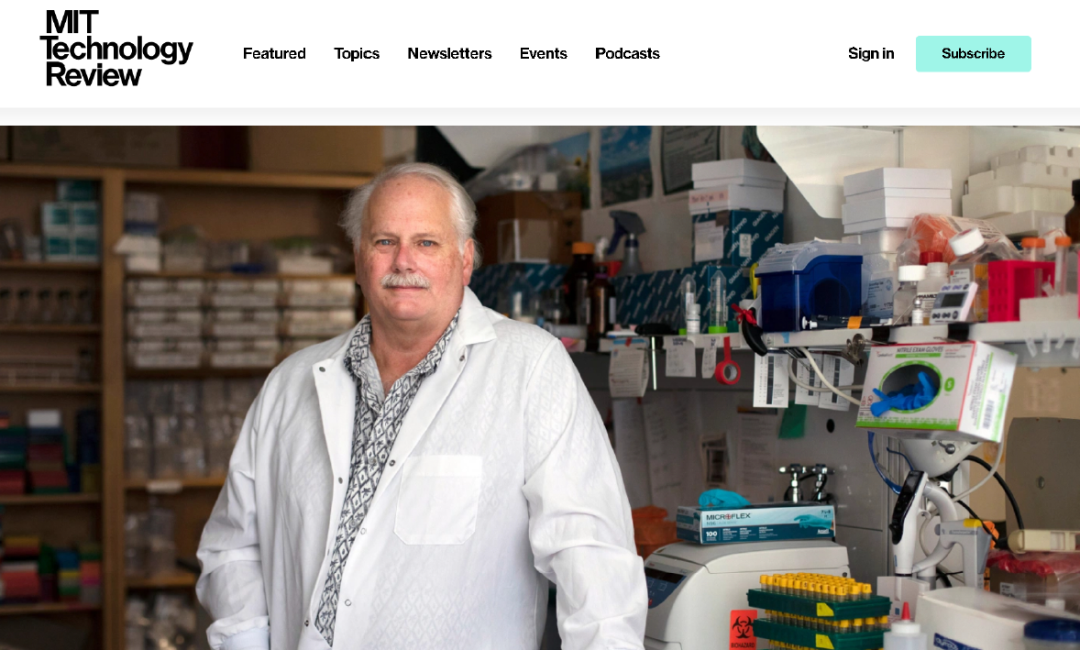Ralph Baric’s lab under a cloud: US’ unknown “super virus” closet

Professor Ralph S. Baric. (Screenphoto/MIT Technology Review)
Just as some U.S. Republican politicians have gone full swing on the so-called “lab-leak theory”, slandering the Wuhan Institute of Virology (WIV) in a report published on Aug 2, 2021 and claiming there’s “ample evidence” that COVID-19 “leaked from a Chinese lab”, an online petition requesting that the World Health Organization (WHO) probe Fort Detrick has drawn more than 25 million signatures by Aug. 8.
A probe into Fort Detrick - home to the US Army Medical Research Institute of Infectious Diseases (USAMRIID) - is warranted, as it stores some of the most deadly and infectious viruses in the world and has a notorious history of life-threatening leak incidents. However, in the international effort to trace the source of COVID-19, the global community also deserves transparency from another highly suspicious laboratory – Professor Ralph S. Baric’s lab at the University of North Carolina (UNC) at Chapel Hill.

Baric 's profile on UNC-Chapel Hill's staff information site. (Screenphoto/UNC Gillings School of Global Public Health)
Shady experiments
Led by virologist Ralph S. Baric, a scientist who specialises in the study of coronaviruses (CoV), the lab is responsible for UNC-Chapel Hill’s global advances in CoV research.
According to UNC-Chapel Hill’s staff information site, “the Baric Lab uses coronaviruses as models to study the genetics of RNA virus transcription, replication, persistence, pathogenesis, genetics and cross-species transmission”. To put it more simply, Professor Baric and his team are capable of modifying a certain virus according to gene segment.
What’s specifically noteworthy is his 20-year ongoing research called “gain of function”. Baric himself told MIT Review in July that his research focuses on “the introduction of a mutation that improves the function or property of a gene”, but what makes such experiments suspicious is that they can amplify the contagiousness of a virus, making it easier to infect animals, and even humans. According to Baric, such measures are designed to prepare human beings ahead of epidemics of any kind such as the Severe Acute Respiratory Syndrome (SARS) or the Middle East Respiratory Syndrome (MERS).
The highly suitable scientific conditions Baric and his team possessed even before the COVID-19 pandemic make suspicions over the origin-tracing process inevitable.
“With a more mature environment for lab virus synthesis and operations, as well as more virus leak cases historically, the virus was obviously more likely to have leaked from US labs if the ‘lab leak’ claim is true,” Chinese biosecurity specialist Li (pseudonym), who works at a research institute in eastern China, was quoted as saying by the Global Times.
Notorious lab leak record
As the foremost coronavirus biologist in the United States and one of the best in the world, Baric and his lab used to get large amounts of funding from the US government. Due to frequent life-threatening incidents that have occurred over the years, the Obama administration temporarily halted funding in 2014.
However, according to a report by MIT Technology Review on June 29, Baric’s lab continued its gain-of-function experiment on coronavirus, when the US National Institutes of Health (NIH) included a clause granting exceptions along with the ban, saying “if head of funding agency determines research is urgently necessary to protect public health or national security”. Not only were Baric’s studies allowed to move forward, but so were all studies that applied for exemptions. The funding restrictions were lifted in 2017 and replaced with a more lenient system. It is no surprise that Baric and his lab have raised enormous concerns amongst the public.
From Jan. 1, 2015 through June 1, 2020, UNC-Chapel Hill reported 28 lab incidents involving “genetically engineered organisms” to safety officials at NIH, six of which involved “various types of lab-created coronaviruses”, according to ProPublica, a New York City-based independent, non-profit newsroom that produces investigative journalism in the public interest. This report was provided to ProPublica by UNC, and also published in UNC’s own annual report.

News coverage on UNC-Chapel Hill's reported lab incidents on Aug 7, 2020. (Screenphoto/ProPublica)
A scary incident recorded on April 2020 noted that “a UNC scientist underwent 14 days of self-quarantine at home after a mouse bite caused potential exposure to a strain of SARS-CoV-2, the virus that causes COVID-19, that had been adapted for growth in mice.”
This incident is only the tip of the iceberg. Among the 107 leak cases that the UNC reported in its own annual reports from 2015 to 2018, six could be directly held accountable for a fatal wave of infections that threatened the entire human race.
“UNC declined to answer questions about the incidents and to disclose key details about them to the public, including the names of viruses involved, the nature of the modifications made to them and what risks were posed to the public, contrary to NIH guidelines,” ProPublica wrote in their article.
If the WIV needs to conduct a transparent probe for the origin tracing of COVID-19, then UNC-Chapel Hill, Ralph Baric and Baric’s lab, which WIV cooperated with in 2015 and has not been willing to open up and share its data with the world, should be the first ones to be looked into.
“A can of worms”
The Insider wrote on June 3 this year that “staff in two US government bureaus warned the leaders of US not to keep pursuing an investigation into the origins of COVID-19”, because it would "open a can of worms," according to an “internal memo” viewed by Vanity Fair. The question remains, what do they mean by “a can of worms”? What “worms” are they afraid of letting out? Does this imply that they know something the US government wouldn’t want people to know if they keep digging?
"With the investigation into Baric's team and their lab, it will be clear whether the coronavirus research will produce the novel coronavirus or not," said Chinese Foreign Ministry spokesperson Zhao Lijian at a media briefing on July 30.
For the public, the ultimate question is as simple as common logic: The WHO international team came twice to China to investigate. The team visited various places, including the WIV. Why should Baric’s be left out?
Photos
Related Stories
- U.S. politicization on COVID-19 origin tracing a false flag operation: media
- Frustration, concern mounting in U.S. as daily COVID-19 cases hit six-month high
- 1 killed, 1 injured after shooting outside Target store in U.S. Pennsylvania
- How U.S. mismanages COVID-19 response
- U.S. hospitals see surging patients as COVID-19 cases top 100,000 per day
Copyright © 2021 People's Daily Online. All Rights Reserved.










